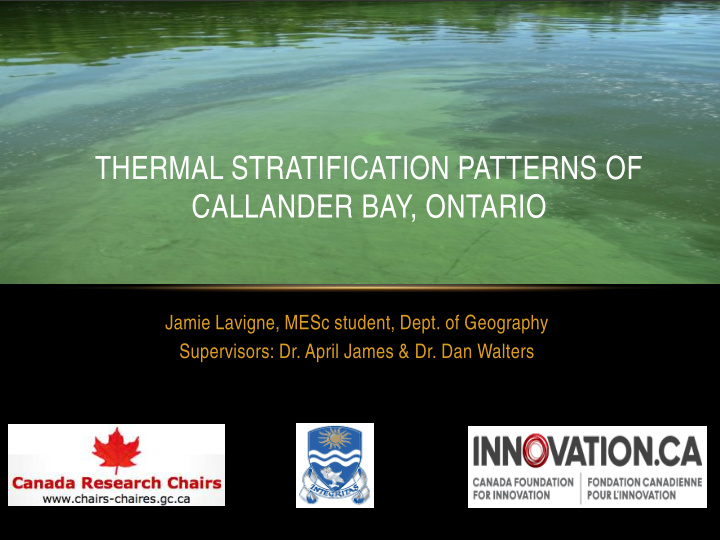



THERMAL STRATIFICATION PATTERNS OF CALLANDER BAY, ONTARIO Jamie Lavigne, MESc student, Dept. of Geography Supervisors: Dr. April James & Dr. Dan Walters
BACKGROUND Callander Bay Catchment area of ~296 km 2 Surface area of ~12 km 2 (Hutchinson Environmental Sciences Ltd. 2011). Municipal drinking water source Recreational use - swimming, boating fishing Reoccurring algal problem Land classes of Callander Bay. Courtesy of Hutchinson Environmental Sciences Ltd. (2011).
BATHYMETRY 8 m 9 m 10 m 7 m Callander Bay bathymetry. Map digitized courtesy of Dr. Krys Chutko. Landscape courtesy of Google earth, 2013.
THERMAL STRATIFICATION Typical temperature profile from a temperate stratified Lake image of summer stratification showing different lake showing three layers based on differences in layers in density. Courtesy of University of Guelph, density. Courtesy of Thomas et al. (1996). (2013).
Coastal and subcoastal non-floodplain sand lake—Window – Hydrology, WetlandInfo, Department of Environment and Heritage Protection, Queensland.
INTERNAL LOADING • Sediments act as a sink for nutrients with the exception of periods of anoxia (lack of oxygen). • During anoxia, nutrients are released into the hypolimnion (bottom waters) (Pettersson, 1998). • Anoxia = < 1 mg/L of dissolved oxygen Oxygen concentration and chlorophyll a. Notice as oxygen depletion occurs chlorophyll a concentration increase in the summer months. Courtesy of Thomas et al . (1996 ).
RESEARCH OBJECTIVES AND SIGNIFICANCE Evaluate the trophic state (algal • Municipal drinking water source biomass) of Callander Bay. • Callander Bay brings revenue/tourism Measure chlorophyll- a , • Excess nutrients cause blue-green algae Secchi depth problems - poses a health threat Assess the stratification pattern and determine whether anoxia occurs. Measure vertical profiles of temperature/dissolved oxygen Can thermal characteristics help to explain bloom formation? Blue-green algae bloom in Callander Bay. Photo courtesy of Paul Smylie, 2011.
Buoy Installation June 2013 Much thanks to MNR – North Bay Dr. Chutko and I after buoy installation, 2013. MNR crew and Dr. Walters helping with installation, 2013
Buoy Removal October 2013 Much thanks to our colleagues at Callander Bay Harper ’ s Marina! Crew from Harper’s Marina and Dr. Walters. Photo courtesy of Dr. James. 2013
EQUIPMENT ON BUOY Rope with equipment that was suspended Schematic of buoy installation and suspended equipment, from buoy, 2013. 2013
BUOY (SITE 6) AND SPOT SAMPLING SITES Weekly spot sampling Continuous + weekly Weather station spot sampling 8 m Site 1 Site 2 Site 3 Site 6 10 m 9 m Site 4 Site 5 7 m Callander Bay bathymetry. Map digitized courtesy of Dr. Krys Chutko and landscape courtesy of Google earth, 2013.
WEATHER STATION • Continuous data • Air temperature • Wind direction • Wind Speed • Barometric pressure Many thanks to Mayor Hector Lavigne!
Data offload Data offload C Equipment fall Isothermal Stratified
Data offload Equipment fall
SUMMARY & FUTURE Successful 1 st year of a m ulti- • year study • Conduct winter sampling • Data from early sum m er • Analyze total phosphorus through late fall. • Early com m ents on stratification patterns • Early season – the system is stratified; late season we lose this stratification – system m ixes • The spot sam pling • acting as useful checks & allowing som e com m ent on spatial extent of sim ilar Dr. Walters sampling water. Photo courtesy of Paul conditions Smylie 2011. • Evidence of anoxic conditions at depth – could this prom ote internal loading? Questions/Comments/Suggestions
Recommend
More recommend